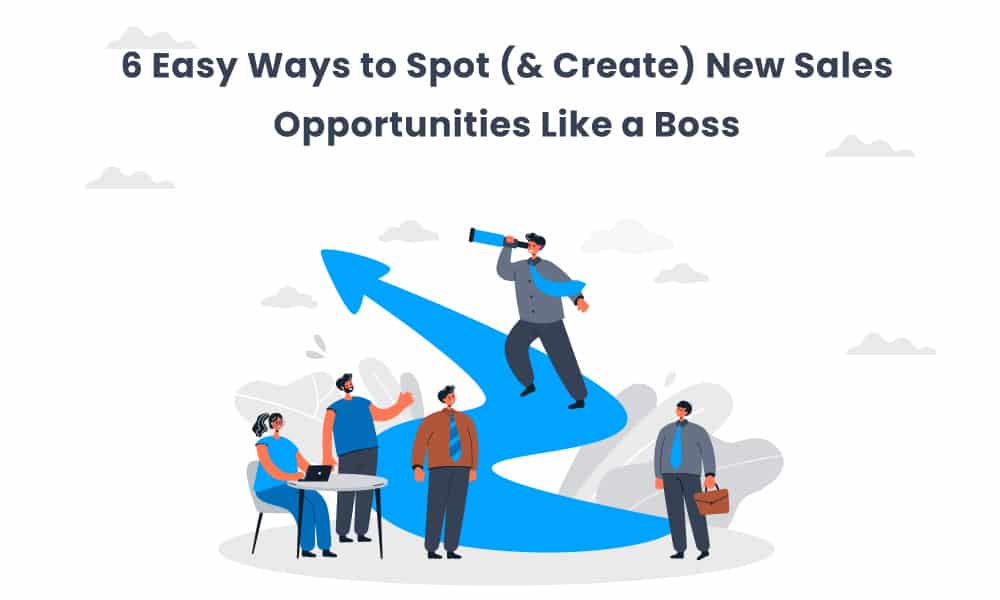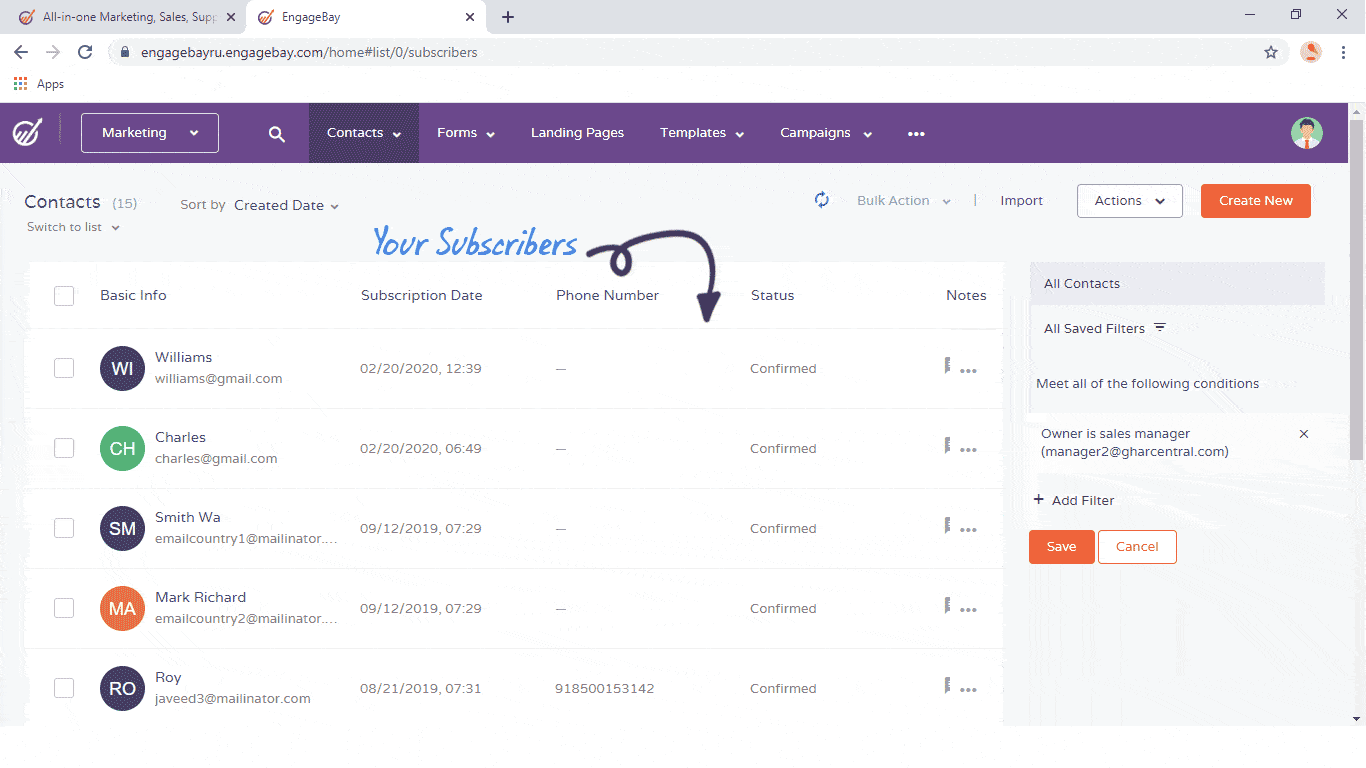Sales opportunities come to salespeople all the time. They appear as happy customers, unplanned sales meetings, and unexpected phone calls.
However, sales teams often don’t pay attention to these sales opportunities because they are in the middle of meetings or some other sales process.
Sales reps need to be constantly on the lookout for sales opportunities and seize them when they arise.
To help you identify sales opportunities before your competitors do, we have compiled six great ways that will point out new prospects. These strategies work for both B2B sales and B2C sales.
In this blog post, we will discuss how you can leverage events & expos, CRM software, affiliate programs, buyer personas, and more to spot new sales opportunities and boost your revenue.
Table of Contents
What Is a Sales Opportunity?
Before we share our handy tips for identifying sales opportunities, let’s be sure you’re clear on the definition of a sales opportunity itself.
When a sales opportunity arises, it’s not necessarily referring to a random lead. A new sales opportunity can always come from an existing customer or a qualified lead.
A qualified lead has been given some information about your company’s products or services, and they’re interested in buying.
It’s possible that you may have contacted the lead for one product or service but they’re more interested in another — that’s a sales opportunity too.
What Is the Difference Between a Lead and a Sales Opportunity?
So how do you tell the difference between a regular lead and one who’s more qualified? It all depends on where they enter the sales funnel.
A lead is someone who may have found your company’s products or services through an advertisement or recommendation.
You might have even met the lead in person at an event, expo “or online” and given them your business card.
They have only the most cursory knowledge of your company and what you do. They know your company name and maybe the name of a product or service you sell, but that’s as far as it goes for them.
They may not have any interest or need for your products or services, but you don’t know that yet. Given the unpredictability of a lead, you can’t say for certain how the sales process will go.
They could convert into a buying customer or they could drop off soon after getting on the sales funnel.
Compare all that to a sales opportunity. The lead here is a sales-qualified lead, or SQL. They’ve gone through some vetting by your sales team to determine their interest and eligibility.
Now, you must make the most of these sales opportunities, talk to these potential customers, and do your best to convert them.
Read also: How to Make a Great Sales Pitch (With 9 Examples)
The Stages of a Sales Opportunity
There are five stages in any sales opportunity: research, qualification, strategizing, execution, and review.
Here’s an overview of each stage.
Stage 1: Research
The first stage of a sales opportunity is one of the most intensive.
While in the research phase, you want to learn as much about your leads as you can. You’re not disqualifying anyone yet, just absorbing information like a sponge.
Stage 2: Lead Qualification
In the second phase, you’ll move on to qualifying your leads. You want to review your company’s sales criteria and use that as the basis to compare each lead.
If a lead doesn’t fit your criteria at this time, set them aside until another sales opportunity arises.
The leads that do fit the criteria could become your SQLs. These are the people you want to focus your attention on.
👉Boost your sales success with the ultimate sales page examples – dive into our in-depth guide today! 🚀
Stage 3: Strategizing
How will you win the sales opportunity and close the deal? That’s what you have to figure out in this stage.
By gleaning more information about the lead, like their pain points, you can begin to formulate a plan that might work to convert them.
Stage 4: Plan Execution
With the plan put in place, by stage 4, you’re ready to execute your plan.
Whatever your strategy, you must get down to executing it step-by-step, and make sure you document all the steps and the progress made in each.

Stage 5: Review
Even a well-detailed sales conversion plan doesn’t always succeed.
Sales managers know by experience that selling is a numbers game, and the more you work at it, the better your chances of success get. That said, it helps to review all progress made/not made in each step of the sales process.
You should document your review of the sales strategy and its execution. This can refine your strategy a lot.
6 Great Ways of Identifying New Sales Opportunities
Let’s dive into our six proven ways of finding more sales opportunities for your small business.
#1. Work with Sales-qualified Leads
The sales process is a series of sequential steps that leads to the sales transaction. Sales qualified leads are those sales prospects that have an interest in buying your product, can afford it, and are ready to buy.
Sales qualified leads are usually generated from sales prospecting efforts, such as cold calling, salesperson-to-salesperson communication, or marketing and sales campaigns.
Lead generation takes time and is often very expensive because sales-qualified leads require a lot of sales resources. Therefore, sales professionals need to make sure they only spend their sales resources on sales qualified leads that have the greatest potential to convert into sales.
You can ask your leads some smart questions about their budget, like: “What’s your ideal total budget?”, “What was the highest amount you spent on a similar solution?”.
This will help you save time and effort, preventing you from following up on unqualified leads.
Another great way of qualifying leads for sales offers is to make sales forecasts based on financials, sales history, or competition analysis.
You can also qualify sales leads by looking at other companies’ sales cycles: when did these leads last buy the same product; how long does the buying process typically take for them?
Their buying patterns will also tell you if they’re interested in your product or not.
Sometimes, prospects realize their limitations and come to you with clear information about what problems they want solved, and how long it takes for them to purchase a solution of the kind you’re offering.
In those cases, no additional qualification is needed since their behavior already qualifies them as sales-qualified leads. Spend more time on converting them and you’ll end up with better results.
Read also: Marketing Funnel & Everything You Need to Know About It
#2. Create Buyer Personas
Even though SQLs have gone through a filtering process and come out the other end identified as readier to buy, that doesn’t mean every single one of them is the same.
Far from it. Your SQLs will come from different parts of the world. They’ll have different genders and age groups. Their occupations and income levels will vary.
Sometimes, their needs aren’t the same either.
You cannot take all your SQLs and apply blanket sales tactics on them in the same way that a marketer shouldn’t send everyone on their email list the exact same message.
Now, in a perfect world, you could take each of your leads and prospects, get to know them a bit demographically, and then sort them.
That would take monumental amounts of time though, and, if you fail to make a sale, that’s major time wasted.
What do smart sales and marketing teams do instead? Create buyer personas. This is a concept we’ve written about in depth.
In short, a buyer persona paints a portrait of your audience. Think of it as a type of profile, but a fictional one.
Well, it’s fictional and it’s not. What do we mean by that? Take a look at this buyer persona example and see if you can figure it out.
Image courtesy of Single Grain
Tommy Technology both is and isn’t a real person. That’s a picture of somebody out there, alright, whose name probably isn’t Tommy.
The personality traits that Tommy Technology embodies are real, though. You’ll find leads, prospects, and customers who match this personality to a T, and others who share a few characteristics, but not all.
The whole point of creating buyer personas is to group your audience into buckets with other like individuals.
If you have several prospects who have similarities to Tommy Technology, then they’d go in one bucket or under that avatar.
The goal is to create avatars for each of the strong personalities you come across. For instance, the slow, reluctant person who needs to do a lot of reading up before they buy.
You also want a persona to accommodate for SQLs and other qualified prospects.
You get to choose the criteria that make each avatar important. In sales, perhaps you do organize leads and prospects by buyer readiness.
You can also segment SQLs based on location, pain points, occupation, or income.
When you come across an SQL or a lead who fits a certain buyer persona, you can quickly see a sales opportunity.
Since you have an avatar that suits this lead and you’ve likely sold to a similar personality before, it becomes easier to close the deal.
Related blog: What is a Sales Pipeline (+ 8 Tips to Manage Yours)
#3. Use Customer Referrals
Sales opportunities don’t have to come out of anywhere, you know. You can also create them. One such way you might do that? Through a referral system.
This time, instead of focusing so much on sales-qualified leads or SQLs, you want to tap into your existing customer base. Like always, do some segmenting. Which customers have the most loyalty, in that they buy the most often? You might also choose to focus on those customers who have stuck with you for the longest.
Then, reach out to them via phone or email. In the message, mention that you’re starting a referral program. Ask them to recommend you to anyone they might know who may have an interest in your products or services.
For a referral program to succeed, you must incentivize your customers to participate. Typically, you can do so via freebies or discounts.
You might offer a bigger reward for the customers that get the most people to participate in the referral program.
Don’t underestimate the power of word of mouth. When a lead hears of a recommendation through a friend, coworker, or family member—aka your customer—they could have a higher chance of taking advantage of your offer.
Marketing resource Annex Cloud says as much. They shared some data from Nielsen that mentions that most consumers (a whopping 92%) will buy something if someone they know recommends it.
Family and friends play a major role in purchasing decisions as well, as 77% of people reported their loved ones influenced their shopping habits.
Also, Annex Cloud found that each day, 2.4 billion conversations will occur in the United States that are centered around a brand. If you want yours to be one of them, consider a referral program.
These programs can succeed in a massive way if done correctly.

#4. Establish Third-Party Referrals or Affiliate Programs
A referral program can drive up your sales, and you’re going to want to milk this cash cow dry, right? Of course.
That’s why we’re also suggesting that you consider a third-party referral relationship.
Although you tend to think of achieving results for your company only, there are billions of other companies striving to boost their sales as well.
They attract their own leads, some more qualified than others. Imagine if you could get a whole new qualified audience from another company, agency, home business, or influencer.
With a third-party referral program, you can. Also called an affiliate program, it works in much the same way as a customer referral program would.
Your affiliates earn money from you when they get someone to buy from you. And yes, it should be money you offer in this case, not discounts or freebies.
Getting the word out about your brand or your products and services in this way can pay off big time. Annex Cloud, in the same article we mentioned before, says that leveraging social media for affiliate marketing produces especially great results.
When consumers see referrals on social media, they have a better chance of buying, up to 71% higher. If you can get your affiliates to spread the word across social media then, the sales could roll right in.

5. Get Out of the Office (Go to Events & Expos)
To find some wonderful sales opportunities, consider attending events, expos, conventions, and the like.
It need not be random. Instead, you want to attend these events strategically. Before you ever buy your event ticket, create a list of potential customers that may be at an expo or convention. Make it a point to go to all such events that attract a lot of your target audience.
Be friendly and speak casually about your company and its products or services. Hand out some business cards. End the conversation on a good note and move on.
If you vetted these contacts well, they should soon be getting in touch with you.
If you don’t already have it, get all their contact information in one place. This will help you in the follow-up sales calls and closing the deals.
We’re not alone to recommend heading out.
As a small business consultant, Ellisa Brenneman told Inc:
“It is a digital age and there are a lot of options to do business far from where we are located … But it may be human nature to want to see the person you’re giving money to or know there is someone who can help you — that there is a face to the service, a face behind the voice.”
6. Use CRM Software
CRM stands for customer relationship management and is often used to refer to the software used for this task.
You can manage all your contacts from one software, segmenting them, nurturing them, contacting them, sending automated responses and newsletters or SMS broadcasts to them, and so on.
While scarce sales opportunities is one issue, many sales reps are overwhelmed with the amount of sales opportunities available.
They need to find sales opportunities that they can afford and have a high potential for success.
CRM software helps sales reps by organizing their sales pipeline, tracking sales progress in real-time, and identifying the key factors associated with individual sales opportunities.
EngageBay’s Sales CRM helps your business with highly actionable insights
As your lead enters your sales funnel and begins moving through it, each interaction gets logged into the CRM software.
Often, marketers and salespeople both reach out to a potential customer and hence annoy the heck out of them. A unified, integrated CRM solution like EngageBay will help you avoid this mess.
By reviewing all customer communications, you can track when a lead might be most sales-ready. In fact, the software itself identifies hot leads with a high score for you, and changes the score automatically based on their behavior.
CRM can also come in handy if you want to go back to less responsive leads later on. For instance, maybe a lead isn’t qualified right now, but that could change.
Their pain points might shift, they might make a career jump, their income or shopping preferences might change, and so on. Trying to track all these changes manually can be exhausting and futile.
Let the CRM software track the online behavior and characteristics of all your leads. The software can even add and remove new leads in email lists based on their latest score.
Read also: How CRM Can Boost Your B2B Marketing
Conclusion
We hope you found this blog post insightful and now have a better understanding of how to spot and create new sales opportunities.
If sales is something you’ve been struggling with, don’t be discouraged!
There are many ways to improve your sales strategy and learn the best practices for what works in business today.
Remember that it is best to associate with other brands and influencers who can refer your products and services, focus on qualified leads rather than all leads, and use CRM software to manage the myriad aspects of a sales process.
EngageBay offers a free-forever plan that you can use to play around with the CRM features. These include sales lead scoring, lead nurturing, SMS broadcasts and email drip campaigns, sales dashboards with customizable metrics, and much more.
Shawn L loves EngageBay. Hear the testimonial from the man himself:
Read also: 9 Business Management Software Hacks for Crazy Productivity





